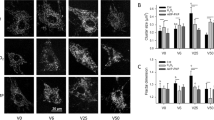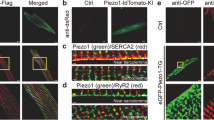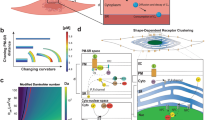Abstract
Cells can be exposed to irregular mechanical fluctuations, such as those arising from changes in blood pressure. Here, we report that ATP production, assessed through changes in mitochondrial membrane potential, is downregulated in vascular smooth muscle cells in culture exposed to monotonous stretch cycles when compared with cells exposed to a variable cyclic stretch that incorporates physiological levels of cycle-by-cycle variability in stretch amplitude. Variable stretch enhances ATP production by increasing the expression of ATP synthase’s catalytic domain, cytochrome c oxidase and its tyrosine phosphorylation, mitofusins and PGC-1α. Such a fluctuation-driven mechanotransduction mechanism is mediated by motor proteins and by the enhancement of microtubule-, actin- and mitochondrial-network complexity. We also show that, in aorta rings isolated from rats, monotonous stretch downregulates—whereas variable stretch maintains—physiological vessel-wall contractility through mitochondrial ATP production. Our results have implications for ATP-dependent and mechanosensitive intracellular processes.
This is a preview of subscription content, access via your institution
Access options
Subscribe to this journal
Receive 12 print issues and online access
$259.00 per year
only $21.58 per issue
Buy this article
- Purchase on Springer Link
- Instant access to full article PDF
Prices may be subject to local taxes which are calculated during checkout






Similar content being viewed by others

References
Janson, I. A. & Putnam, A. J. Extracellular matrix elasticity and topography: Material-based cues that affect cell function via conserved mechanisms. J. Biomed. Mater. Res. A 103, 1246–1258 (2014).
Bereiter-Hahn, J. & Voth, M. Dynamics of mitochondria in living cells: Shape changes, dislocations, fusion, and fission of mitochondria. Microsc. Res. Tech. 27, 198–219 (1994).
Bach, D. et al. Mitofusin-2 determines mitochondrial network architecture and mitochondrial metabolism. A novel regulatory mechanism altered in obesity. J. Biol. Chem. 278, 17190–17197 (2003).
Anesti, V. & Scorrano, L. The relationship between mitochondrial shape and function and the cytoskeleton. Biochim. Biophys. Acta 1757, 692–699 (2006).
Ingber, D. E. Cellular mechanotransduction: Putting all the pieces together again. FASEB J. 20, 811–827 (2006).
Hoffman, B. D., Grashoff, C. & Schwartz, M. A. Dynamic molecular processes mediate cellular mechanotransduction. Nature 475, 316–323 (2011).
Chapman, K. E. et al. Cyclic mechanical strain increases reactive oxygen species production in pulmonary epithelial cells. Am. J. Physiol. Lung Cell. Mol. Physiol. 289, L834–L841 (2005).
Mancia, G. et al. Long-term prognostic value of blood pressure variability in the general population: Results of the Pressioni Arteriose Monitorate e Loro Associazioni Study. Hypertension 49, 1265–1270 (2007).
Ehrenberg, B., Montana, V., Wei, M. D., Wuskell, J. P. & Loew, L. M. Membrane potential can be determined in individual cells from the Nernstian distribution of cationic dyes. Biophys. J. 53, 785–794 (1988).
Kadenbach, B., Ramzan, R., Wen, L. & Vogt, S. New extension of the Mitchell theory for oxidative phosphorylation in mitochondria of living organisms. Biochim. Biophys. Acta 1800, 205–212 (2010).
Yaffe, M. B. Phosphotyrosine-binding domains in signal transduction. Nature Rev. Mol. Cell Biol. 3, 177–186 (2002).
Hinkle, P. C., Kumar, M. A., Resetar, A. & Harris, D. L. Mechanistic stoichiometry of mitochondrial oxidative phosphorylation. Biochemistry 30, 3576–3582 (1991).
Acin-Perez, R., Gatti, D. L., Bai, Y. & Manfredi, G. Protein phosphorylation and prevention of cytochrome oxidase inhibition by ATP: Coupled mechanisms of energy metabolism regulation. Cell Metab. 13, 712–719 (2011).
Lee, I. et al. cAMP-dependent tyrosine phosphorylation of subunit I inhibits cytochrome c oxidase activity. J. Biol. Chem. 280, 6094–6100 (2005).
Helling, S. et al. Phosphorylation and kinetics of mammalian cytochrome c oxidase. Mol. Cell. Proteomics 7, 1714–1724 (2008).
Santel, A. et al. Mitofusin-1 protein is a generally expressed mediator of mitochondrial fusion in mammalian cells. J. Cell Sci. 116, 2763–2774 (2003).
Otera, H., Ishihara, N. & Mihara, K. New insights into the function and regulation of mitochondrial fission. Biochim. Biophys. Acta 1833, 1256–1268 (2013).
Wu, Z. et al. Mechanisms controlling mitochondrial biogenesis and respiration through the thermogenic coactivator PGC-1. Cell 98, 115–124 (1999).
Rambold, A. S., Kostelecky, B., Elia, N. & Lippincott-Schwartz, J. Tubular network formation protects mitochondria from autophagosomal degradation during nutrient starvation. Proc. Natl Acad. Sci. USA 108, 10190–10195 (2011).
Smith, T. G. Jr, Lange, G. D. & Marks, W. B. Fractal methods and results in cellular morphology–dimensions, lacunarity and multifractals. J. Neurosci. Methods 69, 123–136 (1996).
Zhou, X., Li, J. & Kucik, D. F. The microtubule cytoskeleton participates in control of β2 integrin avidity. J. Biol. Chem. 276, 44762–44769 (2001).
Heggeness, M. H., Simon, M. & Singer, S. J. Association of mitochondria with microtubules in cultured cells. Proc. Natl Acad. Sci. USA 75, 3863–3866 (1978).
Rodriguez, O. C. et al. Conserved microtubule-actin interactions in cell movement and morphogenesis. Nature Cell Biol. 5, 599–609 (2003).
Legros, F., Lombes, A., Frachon, P. & Rojo, M. Mitochondrial fusion in human cells is efficient, requires the inner membrane potential, and is mediated by mitofusins. Mol. Biol. Cell 13, 4343–4354 (2002).
Tang, H. L. et al. Vimentin supports mitochondrial morphology and organization. Biochem. J. 410, 141–146 (2008).
Sachs, F. Stretch-activated ion channels: What are they? Physiology 25, 50–56 (2010).
Ito, S. et al. Actin cytoskeleton regulates stretch-activated Ca2+ influx in human pulmonary microvascular endothelial cells. Am. J. Respir. Cell Mol. Biol. 43, 26–34 (2010).
DiPaolo, B. C. & Margulies, S. S. Rho kinase signaling pathways during stretch in primary alveolar epithelia. Am. J. Physiol. Lung Cell. Mol. Physiol. 302, L992–L1002 (2012).
Morano, I. et al. Smooth-muscle contraction without smooth-muscle myosin. Nature Cell Biol. 2, 371–375 (2000).
Parameswaran, H., Lutchen, K. R. & Suki, B. A computational model of the response of adherent cells to stretch and changes in substrate stiffness. J. Appl. Physiol. 116, 825–834 (2014).
Rottenberg, H., Covian, R. & Trumpower, B. L. Membrane potential greatly enhances superoxide generation by the cytochrome bc1 complex reconstituted into phospholipid vesicles. J. Biol. Chem. 284, 19203–19210 (2009).
Iwakura, T. et al. Sustained enhancement of Ca(2+) influx by glibenclamide induces apoptosis in RINm5F cells. Biochem. Biophys. Res. Commun. 271, 422–428 (2000).
Vicente-Manzanares, M., Ma, X., Adelstein, R. S. & Horwitz, A. R. Non-muscle myosin II takes centre stage in cell adhesion and migration. Nature Rev. Mol. Cell Biol. 10, 778–790 (2009).
Arold, S. P., Bartolak-Suki, E. & Suki, B. Variable stretch pattern enhances surfactant secretion in alveolar type II cells in culture. Am. J. Physiol. Lung Cell. Mol. Physiol. 296, L574–L581 (2009).
Arold, S. P., Suki, B., Alencar, A. M., Lutchen, K. R. & Ingenito, E. P. Variable ventilation induces endogenous surfactant release in normal guinea pigs. Am. J. Physiol. Lung Cell. Mol. Physiol. 285, L370–L375 (2003).
Imsirovic, J. et al. A novel device to stretch multiple tissue samples with variable patterns: Application for mRNA regulation in tissue-engineered constructs. Biomatter 3, e24650 (2013).
Morgan, K. Y. & Black, D. L. in Cardiac Tissue Engineering: Methods and Protocols Vol. 1181 (eds Radisic, M. & Black, L. D. III) Ch. 16, 177–187 (Springer, 2014).
Glass, L. Synchronization and rhythmic processes in physiology. Nature 410, 277–284 (2001).
Sollers, J. J. III et al. Understanding blood pressure variability: Spectral indices as a function of gender and age. Biomed. Sci. Instrum. 41, 43–47 (2005).
Shi, X., Huang, G., Smith, S. A., Zhang, R. & Formes, K. J. Aging and arterial blood pressure variability during orthostatic challenge. Gerontology 49, 279–286 (2003).
Egi, A., Kawamoto, M., Kurita, S. & Yuge, O. Systolic arterial pressure variability reflects circulating blood volume alterations in hemorrhagic shock in rabbits. Shock 28, 733–740 (2007).
Booyse, F. M., Sedlak, B. J. & Rafelson, M. E. Jr Culture of arterial endothelial cells: Characterization and growth of bovine aortic cells. Thromb. Diath. Haemorrh. 34, 825–839 (1975).
Fritze, L. M., Reilly, C. F. & Rosenberg, R. D. An antiproliferative heparan sulfate species produced by postconfluent smooth muscle cells. J. Cell Biol. 100, 1041–1049 (1985).
Alford, P. W., Humphrey, J. D. & Taber, L. A. Growth and remodeling in a thick-walled artery model: Effects of spatial variations in wall constituents. Biomech. Model. Mechanobiol. 7, 245–262 (2008).
Venegas, J. G. & Galletti, G. G. Low-pass filtering, a new method of fractal analysis: Application to PET images of pulmonary blood flow. J. Appl. Physiol. 88, 1365–1373 (2000).
Acknowledgements
This study was funded by NIH HL-098976, HL-11174 and HL-122513.
Author information
Authors and Affiliations
Contributions
E.B.-S. contributed conceptually, carried out cell studies, biochemical assays, histology, analysed data and wrote the manuscript; J.I. contributed conceptually and carried out the aorta physiology experiments; H.P. contributed conceptually and analysed images; N.M. made measurements; P.G.A. carried out confocal imaging; T.J.W. analysed images; U.F. contributed conceptually as well as with the human data; B.S. contributed conceptually, made measurements, analysed data and wrote the manuscript.
Corresponding authors
Ethics declarations
Competing interests
The authors declare no competing financial interests.
Supplementary information
Supplementary Information
Supplementary Information (PDF 1167 kb)
Rights and permissions
About this article
Cite this article
Bartolák-Suki, E., Imsirovic, J., Parameswaran, H. et al. Fluctuation-driven mechanotransduction regulates mitochondrial-network structure and function. Nature Mater 14, 1049–1057 (2015). https://doi.org/10.1038/nmat4358
Received:
Accepted:
Published:
Issue Date:
DOI: https://doi.org/10.1038/nmat4358


